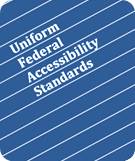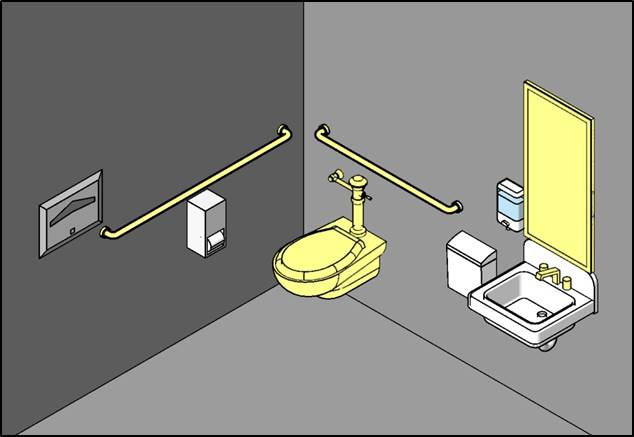This guide provides an introduction to the scoping requirements of the ABA Standards and is intended to be used with a complete copy of the ABA Standards since it does not contain or address the full content of the Standards. It is important that users familiarize themselves with the specific scoping requirements contained in the ABA Standards.
General
[§F202.1]

Additions, alterations, and leasing actions may require retrofit of existing elements. Existing elements that meet earlier editions of the ABA standards, such as the Uniform Federal Accessibility Standards, do not have to be modified to meet the current standards unless altered (§F203.2).
Additions and alterations undertaken at existing facilities are covered by the ABA Standards. The extent of application is largely determined by a project’s scope of work as the standards apply to those elements or spaces that are altered or added. Additional requirements apply to projects that affect or could affect the usability of, or access to, an area containing a primary function. The standards also require certain elements and spaces to comply in existing facilities leased by Federal agencies.
Additions
[§F202.2]
Projects that increase, expand, or extend a facility’s gross floor area or height of a facility are considered additions (as defined in §F106.5) and must comply with requirements of the standards applicable to new construction. However, existing elements and spaces affected by an addition are treated as alterations and qualify for certain allowances or exceptions that are not permitted in new construction.
Application of the Standards in Additions

Requirements for Additions
If not included in an addition, these elements and spaces must be made accessible in the existing facility, where provided:
- toilet and bathing facilities for each sex (an accessible unisex facility is allowed where only 1 toilet or bathing facility is provided or where compliance to multi-user facilities is technically infeasible)
- a public telephone
- a drinking fountain

At least 1 accessible route is required from site arrival points (accessible parking, passenger loading zones, public streets and sidewalks, and transit stops, where provided) to an accessible addition entrance. If the addition does not have its own entrance, an entrance of the existing facility must be made accessible to serve the addition and an accessible route must serve all accessible spaces and elements of the addition.
These requirements apply fully to all additions. Cost caps based on “disproportionality” are not recognized for additions (but are permitted for a path of travel to altered primary function areas).
Alterations
[§F202.3]
Alterations are defined in the standards (§F106.5) as “a change in a building or facility that affects or could affect the usability of a building or facility or portion thereof.” Many types of projects are covered as “alterations”, including remodeling, renovation, rehabilitation, reconstruction, restoration, resurfacing of circulation paths or vehicular ways, and changes or rearrangement of structural parts, elements, or walls. Normal maintenance, reroofing, painting or wallpapering, or changes to mechanical and electrical systems are not considered alterations unless they affect a facility’s usability. For example, a project limited to an HVAC system that includes the addition of thermostats would affect a facility’s usability because it involves elements (operable parts) covered by the standards.
The standards ensure that the opportunities for accessibility presented by an alteration are taken. How and to what extent the standards apply is determined by the scope of a project and the elements and spaces altered. Only those elements or spaces altered are required to comply, but alterations made to areas containing a primary function (a major activity for which a facility is intended) also require an accessible path of travel.
Application of the Standards in Alterations
 If alterations are limited only to elements in a room or space, then the standards apply only to the elements altered. Similarly, where spaces are altered, the standards apply to those spaces that are altered. If a room or space is completely altered (or built new as part of an alteration), the entire room or space is fully subject to the standards. Compliance is required to the extent that it is technically feasible.
If alterations are limited only to elements in a room or space, then the standards apply only to the elements altered. Similarly, where spaces are altered, the standards apply to those spaces that are altered. If a room or space is completely altered (or built new as part of an alteration), the entire room or space is fully subject to the standards. Compliance is required to the extent that it is technically feasible.
Example: Toilet Room Alterations

The standards do not require alterations to exceed the level of access required in new construction. For example, spaces that are exempt in new construction are also exempt in alterations.
Prohibited Reduction in Access
New construction requirements also set the baseline for any alteration that would effectively reduce existing accessibility. Alterations that reduce accessibility below the level that would be required in new construction are prohibited. Reductions in access are allowed only where, and to the extent that, the minimum level required in new construction is exceeded. For example, if an alteration will reduce the number of parking spaces on a site, accessible parking spaces can be proportionately reduced as long as the minimum required in new construction (based on the parking facility’s new total) is met. Elements that are not required by the standards to be provided for accessibility, such as phones, can be completely removed from a site.
Special Provisions for Alterations

The standards apply the same requirements used in new construction to alterations but also include provisions unique to alterations. Some provisions clarify application, while others are structured as exceptions that limit coverage or relax technical criteria under certain conditions. Located throughout the standards at the relevant scoping or technical requirement, these provisions and exceptions are distinguished by references to “alterations” or “existing facilities.”





Technical Infeasibility
Compliance in an alteration is not required where it is “technically infeasible.” The term is defined as “something that has little likelihood of being accomplished because existing structural conditions would require removing or altering a load-bearing member that is an essential part of the structural frame; or because other existing physical or site constraints prohibit modification or addition of elements, spaces, or features that are in full and strict compliance with the minimum requirements.”
Where technical infeasibility is encountered, compliance is still required to the maximum extent technically feasible.
Example of Technical Infeasibility

Other examples where compliance could potentially be technically infeasible include:
- conflicts with applicable building, plumbing, life safety or other codes (such as when combining two toilet stalls to create an accessible stall would violate the plumbing code’s required fixture count);
- meeting slope requirements on existing developed sites located on steep terrain where necessary re-grading and other design solutions are not feasible; or
- work that would impact load-bearing walls and other essential components of the structural frame, including structural reinforcement of the floor slab.
Alterations Affecting Primary Function Areas
[§F202.4]
Additional requirements apply when alterations are made to areas containing a “primary function”, which is a major activity intended for a facility. Examples of primary function areas include dining areas of a restaurant, retail space in a store, exam rooms in a doctor’s office, classrooms in a school, and offices and other work areas where the activities of a covered entity are carried out. Spaces not considered primary function areas include entrances, corridors, restrooms, break rooms, employee locker rooms, and mechanical or electrical closets. Restrooms are not primary function areas unless their provision is the primary purpose of a facility, such as a highway rest stop.

Accessible Path of Travel
When alterations are made to a primary function area, an accessible path of travel to the area must be provided. The accessible path of travel must extend from the altered primary function area to site arrival points, including public sidewalks and parking and passenger loading zones provided on the site. The path of travel also includes access to restrooms, telephones, and drinking fountains, where provided to serve the primary function area.
Disproportionality (20%)
The accessible path of travel is required to the extent that it is not “disproportionate” to the total cost. Regulations and directives implementing the standards define “disproportionate” as exceeding 20% of the total cost of alterations to the primary function area. The 20% cap applies only to costs associated with the accessible path of travel, including an accessible route to the primary function area, entrances, and retrofits to restrooms, telephones, and drinking fountains.
Prioritization
Additional information on the requirements for alterations to primary function areas is provided in regulations and directives implementing the ABA standards.
Compliance is required up to the point the 20% cost cap is reached, even where it does not result in a fully accessible path of travel. Where costs exceed this cap, ABA standard-setting agencies recommend compliance in this order of priority:
- an accessible entrance
- an accessible route to the primary function area
- restroom access
- an accessible telephone
- an accessible drinking fountain
- accessible parking
Accessible Path of Travel

Alterations to Qualified Historic Facilities
[§F202.5]

The standards contain specific provisions for qualified historic facilities which are defined as buildings or facilities that are “listed in or eligible for listing in the National Register of Historic Places or designated as historic under an appropriate State or local law.”
Like other existing facilities, the requirements for alterations apply in relation to the planned scope of work. Alterations provisions and exceptions, including those based on technical infeasibility, and requirements for path of travel to primary function areas, apply equally to historic facilities.
The standards also provide several exceptions where compliance with the standards would threaten or destroy the historic integrity or significance of a facility as determined by the appropriate State Historic Preservation Official or Advisory Council on Historic Preservation. These exceptions apply to requirements for accessible routes (§F206.2) entrances (§F206.4), and toilet rooms (§F213.2).

Leases
[§F202.6]

The General Services Administration (GSA) leases facilities on behalf of many federal agencies._ Regulations from GSA and other agencies implementing the ABA standards further explain leasing actions covered.
Existing facilities leased in whole or in part by federal agencies must meet a minimum level of access specified in the standards. These requirements apply when a new lease is negotiated, even when the space was previously occupied by a federal agency. Compliance is not required at facilities that are either leased:
- for 12 months maximum without renewal or extension options; or
- on a temporary, emergency basis for government officials providing disaster relief services.
Certain elements, spaces, and routes are required to comply to ensure a minimum level of usability. Other elements are required to comply only if altered or added. Facilities that are built for leasing by federal agencies must fully comply with standards as new construction.
Requirements for Federally Leased Space

Requirements for Federally Leased Space

Common Questions

What requirements of the standards apply in an alteration?
Application of the standards in an alteration is determined by the scope of work and whether it involves areas containing a primary function. Altered elements or spaces must comply with relevant provisions of the standards except where compliance is technically infeasible. Where compliance is technically infeasible, compliance is required to the maximum extent feasible. If alterations are made to an area containing a primary function (a major activity for which a facility is intended), an accessible path of travel from the area to site arrival points, as well as the restrooms, telephones, and drinking fountains serving the area, must be made accessible as part of the work to the extent it is not “disproportionate” (more than 20% of the total cost).
How is “technically infeasible” determined in an alteration?
Determining “technical infeasibility” requires a site-specific assessment of constraints or complications in relation to the planned scope of work. The term, as defined in the standards (§106), is intended to encompass design, site, engineering or other constraints that prohibit compliance. Examples include work that would impact a facility’s structural frame or that would conflict with applicable codes or building requirements.
Do the standards apply to existing facilities that are not being altered?
The ABA Standards only address existing facilities where alterations or additions occur or where facilities are leased by federal agencies. However, the Rehabilitation Act (section 504) requires access to federally funded or conducted programs and may necessitate retrofits to existing facilities where no other alterations are planned. The obligation to provide “program access” can sometimes be satisfied operationally, such as by relocating a program, but retrofits to remove existing access barriers are often necessary.




